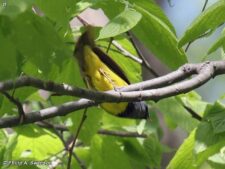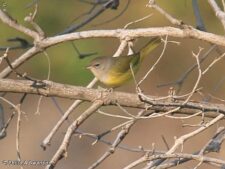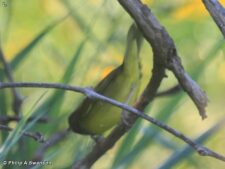
5.25 inches long. The Mourning Warbler has olive upperparts and wings and bright yellow underparts. The male has a dark blue-gray hood and a black breast band and lores and lacks a white eye ring. The undertail coverts are yellow and the tail has no spots. The female is similar with a light gray hood and has a narrow broken eye ring. On immature birds the hood is missing but there is a hint of a broken olive-gray breast band and a broken white eye ring. The similar Connecticut Warbler is a paler yellow underneath and has a bold eye ring. All plumages of the similar MacGillivray’s Warbler have bolder white eye arcs. Also in a MacGillivray’s Warbler, the tail extends much further beyond the undertail coverts than on the Mourning Warbler. In fall the similar Common Yellowthroat has a white belly.
The Mourning Warbler is an uncommon migrant in the area. It is a rather late migrant that is seen from early/mid May through early June. It is also seen from late August through late October.
The Mourning Warbler is found in dense undergrowth and thickets. It hops on the ground rather than walking. The song is a two part “churee, churee, turi, turi” with the second part lower in pitch.
Disclaimer: The content of NatureSearch is provided by dedicated volunteer Naturalists of Fontenelle Forest who strive to provide the most accurate information available. Contributors of the images retain their copyrights. The point of contact for this page is: Phil Swanson.



